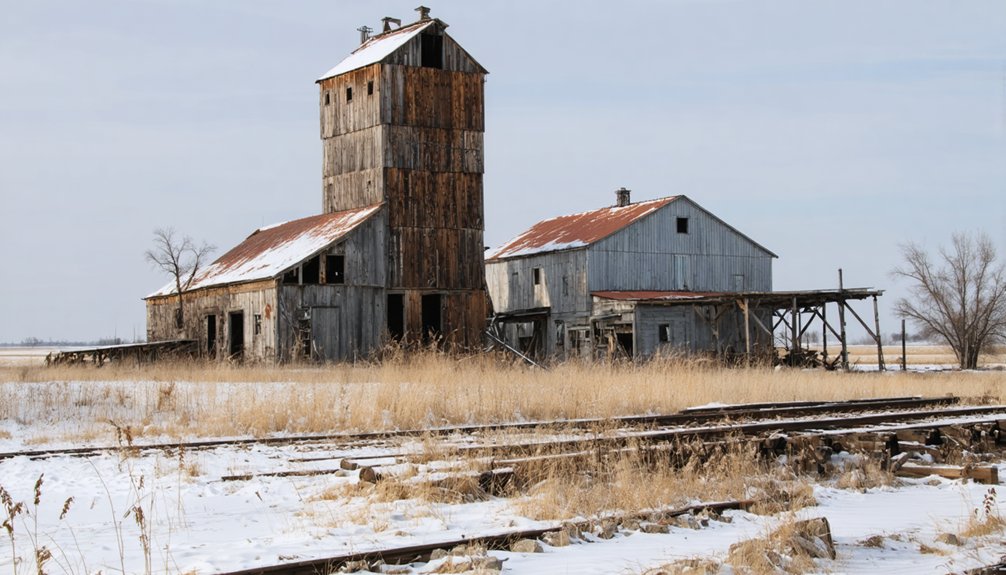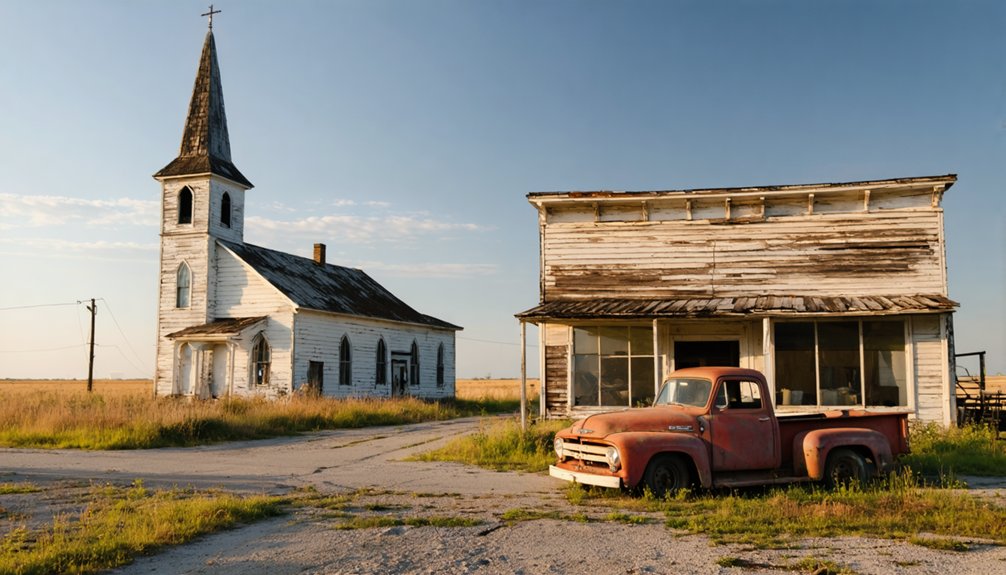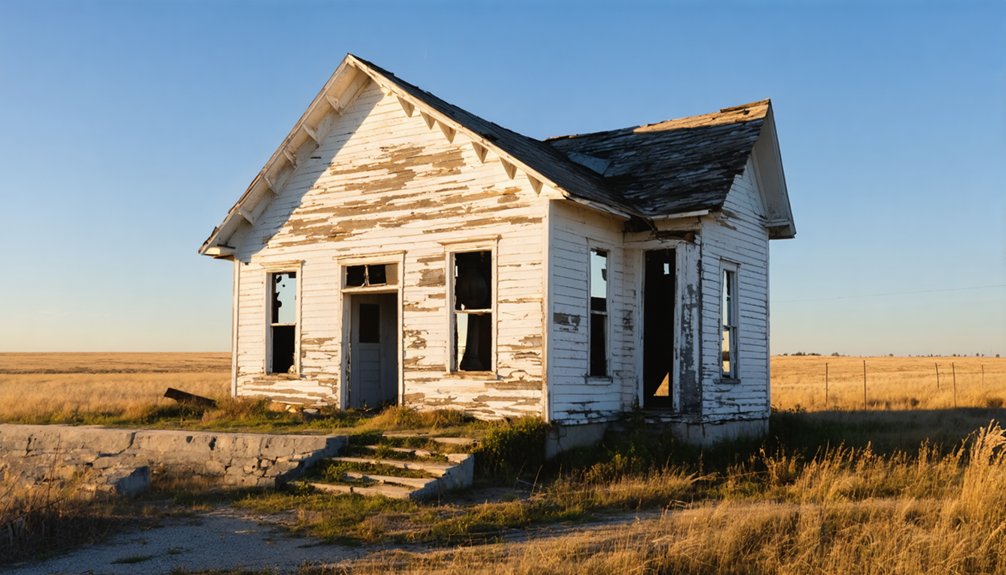You’ll find Richmond’s ghost town remnants near Aberdeen, South Dakota, where this railroad settlement thrived from 1907-1967. The Minneapolis and St. Louis Railroad stop supported a bustling grain trade hub with a depot, elevator, stockyard, and lumberyard serving local farmers. Environmental challenges like 1930s droughts and the Great Depression hit hard, leading to the post office’s 1913 closure. Today, scattered ruins near Richmond Lake tell a deeper story of prairie boom and bust.
Key Takeaways
- Richmond was established in 1907 as a railroad settlement near Aberdeen, South Dakota, thriving initially due to the Minneapolis and St. Louis Railroad.
- The town’s economic foundation centered on its grain elevator and railroad facilities, serving local farmers until operations ceased in 1967.
- Environmental challenges, including 1930s droughts and severe flooding, contributed significantly to Richmond’s decline and eventual abandonment.
- The post office closed in 1913, marking an early sign of the town’s decline as services and population gradually disappeared.
- Today, Richmond exists as a ghost town with only scattered remnants of its railroad-era infrastructure near Richmond Lake.
The Birth of a Prairie Railroad Town
When the Minneapolis and St. Louis Railroad expanded into Brown County, South Dakota in the early 1900s, it sparked the birth of Richmond, a strategic prairie settlement.
Just as Richmond, Virginia’s multiple rail lines were crucial to transportation development in their region, Richmond, South Dakota aimed to become a vital rail stop on the prairie.
By 1909, the town had grown to a population of 144 residents.
You’ll find this town’s origins traced to March 19, 1907, when railroad planners platted it northwest of Aberdeen to serve the rural region.
The railroad expansion brought quick development, with essential structures rising around the tracks.
As steel rails stretched across the prairie, buildings sprouted like wildflowers beside them, transforming empty land into vibrant settlements.
You’d have seen a bustling community hub emerge, complete with a depot, grain elevator, stockyard, and lumberyard. A store and agent’s house rounded out the town’s core infrastructure.
Daily Life in Early Richmond
Life in early Richmond centered around the railroad’s steady rhythm, shaping daily routines for its 144 residents. You’d find people gathering at the multi-purpose buildings that served as general stores, post offices, and social hubs near the depot.
Daily interactions revolved around cooperative labor, with families helping each other survive the harsh prairie conditions. You’d start your day heading to the market or attending to farmland, while your children walked to the one-room schoolhouse. The arrival of rail lines in the late 1870s transformed the way residents connected to other communities and conducted trade.
Community gatherings often took place at the grain elevator, where you’d catch up on local news while conducting business. When supplies ran low, you’d make your way to the general store, where the storekeeper would update you on incoming shipments and share word-of-mouth news from neighboring towns.
Agricultural Foundations and Commerce
You’ll find Richmond’s early commercial success centered on its strategic railroad connection, which enabled the Minneapolis & St. Louis Railway to transport grain from the town’s elevator and livestock from its stockyard.
Local farmers brought their wheat, corn, and cattle to Richmond’s facilities, where the 1907 grain elevator and stockyard formed the backbone of agricultural trade.
The general store, established alongside the post office, provided essential farming supplies, household goods, and feed, creating a hub for both agricultural commerce and community needs. The town’s development was accelerated by the construction of a local train depot that served as a vital transportation center.
Rail-Supported Grain Trade
As Richmond, South Dakota emerged alongside the Minneapolis and St. Louis rail line in 1907, it quickly became a crucial hub for regional grain trade.
You’ll find that the town’s strategic rail infrastructure, anchored by its depot and grain elevator, transformed local agriculture into a thriving commercial enterprise.
The elevator technology was cutting-edge for its time, featuring mechanized systems that efficiently moved grain from farm wagons to storage bins and onto railcars.
This advancement in grain logistics allowed Richmond’s facilities to handle massive volumes of spring wheat, oats, barley, and flaxseed from surrounding farms.
The elevator operated until 1967, outlasting many other local businesses and demonstrating the enduring significance of rail-supported grain commerce in South Dakota’s agricultural economy.
The town’s early success was evident as its population reached 144 within just three years of establishment.
Livestock and Feed Operations
Richmond’s agricultural economy extended well beyond grain processing, with a robust livestock and feed operation emerging alongside the Minneapolis and St. Louis Rail Line around 1907.
You’ll find the stockyards played an essential role in livestock transportation, serving as a critical hub where cattle were held before their journey by rail to larger markets. Local ranchers benefited from the town’s feed production capabilities, as Richmond’s feed mill transformed grains into livestock feed. Similar to the town of Alsen’s creamery operation, Richmond maintained strong agricultural commerce through its various facilities.
The town’s economic significance depended heavily on these agricultural services, with the stockyards and feed mill attracting complementary businesses.
When droughts hit in the 1930s, they struck both the livestock and feed operations hard. The eventual relocation of the rail depot dealt a final blow to Richmond’s livestock commerce, accelerating the town’s decline.
General Store Services
The general store stood as the commercial cornerstone of Richmond’s agricultural community, offering far more than basic retail goods.
Through essential general store interactions, you’d find important farming supplies, from seeds and fertilizers to tools and machinery parts. You could access mail services, coordinate grain shipments, and connect with regional markets through the store’s strategic location near the Minneapolis and St. Louis Rail Line depot. Like many communities that became ghost towns later, Richmond’s general store was vital to early economic development. The store provided crucial lumber mill supplies after sawmills were established to meet growing construction demands.
The store’s agricultural product distribution network made it indispensable for your farming success.
You’d secure feed supplements, fencing materials, and equipment maintenance supplies while arranging freight services for your crops and livestock. The store also provided significant financial flexibility through credit and barter options, helping you manage seasonal cash flow challenges that were common in rural agricultural operations.
The Minneapolis and St. Louis Rail Line Era

In 1870, Minneapolis flour millers founded the Minneapolis and St. Louis Rail Line to break free from larger railroad monopolies. By 1884, you’d have seen the tracks reaching Watertown, South Dakota, marking a significant expansion of this independent railroad’s economic impact. The passenger fare cost was just ten cents to Minneapolis.
The line’s arrival in Richmond in 1907 transformed the small town into a bustling hub of commerce. You would’ve witnessed the railroad’s essential role in Richmond’s development, where it established important facilities including a depot, grain elevator, and stockyard. The town’s development was guided by townsite agent Thomas Way, who played a key role in establishing communities along the rail line.
The M&StL’s presence meant freedom for local farmers who could now efficiently transport their wheat east while receiving necessary supplies from distant markets. The railroad history of Richmond demonstrates how the M&StL served as a critical lifeline, connecting this frontier town to the broader Midwest economy.
Economic Peak and Community Growth
Richmond’s economic zenith emerged in the early 1900s when the Minneapolis and St. Louis Rail Line’s depot transformed the town into a bustling agricultural hub.
You’ll find that during these peak years, Richmond’s 144 residents supported a thriving commercial district that included a grain elevator, stockyard, lumberyard, and general store.
The town’s strategic position along the railroad enabled efficient transport of agricultural goods, establishing Richmond as an essential trade center for the surrounding farming community.
Railroad Drives Town Growth
Railroad expansion in 1907 transformed Richmond, South Dakota from an empty prairie into a bustling commercial hub when the Minneapolis and St. Louis rail line arrived.
You’ll find that town planners and speculators strategically influenced the railroad’s route to maximize development opportunities and land values. Within just three years, Richmond’s population grew to 144 residents as the rail connection spurred rapid settlement and commerce.
- A depot emerged alongside crucial facilities including a grain elevator, stockyard, and lumberyard.
- The railroad enabled farmers to ship agricultural products to distant markets.
- Rail sidings and spurs connected Richmond to the regional economy.
- The depot served as a crucial communications center, handling freight, mail, and telegraphic messages.
This transportation lifeline brought the supplies needed for settlement while creating economic opportunities that would shape Richmond’s early growth.
Commerce and Trade Flourish
The arrival of rail service catalyzed Richmond’s transformation into a vibrant commercial center by 1909.
You’d find a thriving community of 144 residents supported by essential businesses, including a general store, bank, and drug store. The town’s agricultural backbone was evident in its multiple grain elevators, stockyards, and feed mill, which served local farmers’ needs.
Richmond’s commercial success extended beyond farming. You could visit two hotels, consult a lawyer or physician, or get your equipment fixed at the blacksmith shop.
The bustling depot facilitated grain shipments while providing a hub for community events and local governance. The town’s diverse mix of retail outlets and professional services created a self-sufficient economy that supported both residents and surrounding rural settlements, marking Richmond’s peak as a regional trade center.
Peak Population Years
Between 1909 and 1911, a surge of settlers and entrepreneurs transformed Richmond from a modest hamlet of 144 residents into a bustling community of 600 people.
You’d have witnessed dramatic demographic changes as the town’s rapid growth brought diverse community services, from medical care to retail shops.
- Two physicians and a drug store provided essential healthcare while serving the town’s peak population.
- Multiple restaurants, banks, and retail shops created a self-sustaining commercial district.
- The railroad depot, stockyard, and grain elevator formed the economic backbone.
- Educational and religious institutions supported the social fabric of the growing community.
Environmental Challenges and the Great Depression
Devastating droughts during the 1930s Great Depression struck Richmond, South Dakota with particular ferocity, crippling local farmers and ranchers who struggled to maintain their livelihoods.
The environmental impact rippled through the community as wells ran dry and desperate residents dug deeper for water, sometimes with tragic consequences.
As wells turned to dust, Richmond’s desperate search for water led to unforeseen tragedies that scarred the community forever.
You’ll find that Richmond’s economic resilience was further tested by severe flooding that disrupted essential transport routes and infrastructure.
The town’s challenges multiplied as the Minneapolis and St. Louis Rail Line, once Richmond’s lifeline, began to crumble.
With the post office’s departure in 1913 and the depot’s relocation to Long Lake by 1926, Richmond’s role as a transport hub diminished.
The lack of timber resources and abandoned rail lines sealed the town’s fate, severing crucial economic connections.
Signs of Decline and Population Loss

Signs of Richmond’s impending decline emerged shortly after its 1907 founding, when critical infrastructure began slipping away from the young settlement. The town’s population dynamics showed a clear downward trend, peaking at 144 residents in 1909 before steadily falling.
You’ll find the pattern of rural decline reflected in the loss of key services:
- The post office’s relocation to Wetonka in 1913 marked the first major blow
- By 1926, the railroad depot had moved to Long Lake, severing a crucial transportation link
- The grain elevator’s closure in 1967 signaled the end of significant commercial activity
- Competition from growing towns like Aberdeen and Warner drew away remaining residents and businesses
These changes transformed Richmond from a promising rail town into another South Dakota ghost town, mirroring the fate of many similar rural communities.
The Final Years of Richmond’s Grain Elevator
The Richmond grain elevator stood as the town’s last major business operation, persisting through decades of community decline until its final closure in 1967.
You’d have found this wooden crib-style structure facing mounting operational challenges in its final years, as newer concrete and steel facilities in the region offered more efficient grain handling capabilities.
Despite regular elevator maintenance to reinforce its stacked lumber and steel rods, the aging facility struggled to compete with modernized operations elsewhere.
While it continued serving local farmers with grain storage, purchasing, and basic agricultural supplies, the elevator’s role diminished as transportation patterns shifted away from rail service.
The facility’s closure marked the end of Richmond’s sixty-year role as an agricultural hub near what’s now Richmond Lake.
Legacy and Remnants Today

While Richmond’s once-bustling community has largely vanished, you’ll still find scattered remnants of its railroad-era infrastructure near Richmond Lake today.
For those interested in ghost town exploration, the site offers glimpses into South Dakota’s agricultural past through weathered foundations and traces of the original railway line.
- Physical remains include the old grain elevator site, stockyard foundations, and fragments of the original lumberyard.
- Natural reclamation has integrated many ruins into the landscape, creating a unique blend of history and environment.
- Local historians preserve Richmond’s story through photographs, oral histories, and documentation of its 1909-1913 post office.
- Historical preservation efforts focus on maintaining records rather than structures, as most buildings have succumbed to time and erosion.
Frequently Asked Questions
Were There Any Churches or Schools Established in Richmond During Its Existence?
You won’t find documented church history or education legacy in Richmond’s records, though nearby towns had both. While similar settlements typically established these institutions, no direct evidence exists for Richmond.
What Happened to the Buildings and Structures After Richmond Was Abandoned?
Crumbling walls and weathered foundations are all you’ll find now. The abandoned structures deteriorated naturally over time, with Richmond’s grain elevator lasting until 1967 before joining other buildings in returning to the prairie.
Did Any Notable Crimes or Incidents Occur in Richmond’s History?
You won’t find documented crimes or major historical incidents in Richmond’s records. The town’s story focuses mainly on its economic struggles and eventual abandonment during the Dirty Thirties.
What Was the Average Property Value in Richmond During Its Peak?
You won’t find exact property values from Richmond’s peak years, but economic factors suggest modest prices typical of small rail towns, with property trends following the boom-bust cycle of similar South Dakota communities.
Were There Any Attempts to Revive or Preserve Richmond After Decline?
You won’t find documented revival efforts for Richmond after its major decline. Despite state preservation programs being available, this ghost town faced preservation challenges without significant community-led restoration attempts or historical society initiatives.
References
- https://blackhillsvisitor.com/learn/galena/
- https://aberdeenmag.com/2019/01/the-ghost-towns-of-brown-county/
- https://www.legendsofamerica.com/galena-south-dakota/
- https://www.southdakotamagazine.com/galenas-ghosts
- https://www.geotab.com/ghost-towns/
- https://stephentravels.com/top5/ghost-towns/
- https://en.wikipedia.org/wiki/List_of_ghost_towns_in_South_Dakota
- https://bchsofsd.com
- https://icatchshadows.com/okaton-and-cottonwood-a-photographic-visit-to-two-south-dakota-ghost-towns/
- https://www.richmondrailroadmuseum.com/railroad-history



